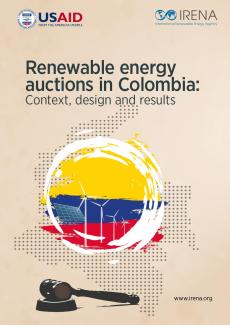This case study examines the context, design, and results of auctions in Colombia that diversified the country’s energy mix by bringing in private investment.
Many developing countries are creating policy, legal, and regulatory frameworks to attract private investment in clean energy, increase energy efficiency, and expand electricity access. USAID works in partner countries across all aspects of the energy sector to reduce emissions and accelerate the clean energy transition.
Colombia’s electricity sector depends heavily on hydropower, which is vulnerable to extreme climate conditions such as El Niño. In 2019, the country had 18 gigawatts (GW) of installed generation capacity, of which hydropower accounted for 66 percent, followed by fossil fuel power plants with a share of about 31 percent. Heavy reliance on hydropower made the Colombian system’s reliability dependent on the amount of water stored, rather than on installed capacity. Between 2015 and 2016, when El Niño strongly affected Colombia, hydro generation fell to 64 percent of total generation, well below the average of 70 percent from 2000 to 2018. Fossil fuel generation made up for the decreased output of hydropower.
Design of Renewable Energy Auctions
In 2019, Colombia became the latest Latin American country to deploy renewable energy auctions. The decision, which built on previous experience with firm energy auctions (used to contract conventional energy), came after the unbundled and liberalized market failed to promote the deployment of non-hydro renewable energy on a large scale.
The Government of Colombia (GOC), with support from USAID, designed renewable energy auctions to bring private investment to diversify the generation mix, while promoting competition among retailers (and generators) to conclude long term (15 yr) electricity contracts at prices that were both competitive and adequate to meet demand.
Renewable Energy Auction Results
Colombia’s first renewable energy auction in February 2019 assigned bids between buyers and sellers but did not award contracts because the auction’s competition criteria were not met, despite high participation rates.
The following modifications to the auction design allowed the second auction in October 2019 to award contracts:
- Auction demand – To date, Colombia’s two renewable energy auctions auctioned energy (measured in megawatt hours (MWh)), not installed capacity (measured in megawatts (MW)). Auctions of energy address the needs of an energy-constrained system, as additional MWh can reduce the stress on water reservoirs during extreme climate conditions such as El Niño. GOC set the target demand in terms of MWh/year in the first auction and MWh/day in the second auction.
- Qualification requirements and documentation – Strict or overcomplicated qualification requirements and documentation can reduce investors’ interest in participating in an auction. But if requirements are too lax, project completion and performance can be compromised. Colombia’s first auction had more complicated qualification requirements than the second one.
- Winner selection criteria – The bidding mechanism in the two auctions was a double-sided (multi-buyer and multi-seller), sealed-bid auction. On the day of the auction, the sealed bids were opened and evaluated by the auctioneer. A double-sided auction complicates the task of matching supply with numerous buyers. In the first auction, the selection of winning bids was determined by an optimization algorithm that assigned contracts based on price and competition criteria. In the second auction, the selection of the winning bids was aimed to find the combination of energy packets that minimized contract costs for consumers.
- Risk allocation – Both buyers and sellers had to submit commitment bonds as financial guarantees. In the first auction, generators had to provide a bid bond of 135 Colombian pesos (COP) per kilowatt hour (kWh) ($.0425/kWh) multiplied by the annual mean energy for sale. In the second auction, some of the commitment bonds were reduced, following feedback from stakeholders. The contract duration of power purchase costs was extended from 12 to 15 years. Perhaps the most significant change was the shift from take-and-pay contracts to take-or-pay. The buyers in the second auction assumed the obligation of paying the contracted amount to generators regardless of consumption. Any difference would be settled on the spot market, whereas the first auction stipulated yearly settlement periods. These changes improved generators’ risk perceptions.
The second auction secured around 1.3 GW of new wind and solar photovoltaic (PV) capacity, scheduled to become operational by 2022. This was a positive step toward the diversification of Colombia’s installed generation capacity, with solar PV and onshore wind shares expected to increase from less than 1 percent in 2019 to about 12 percent by 2022.
At $28.40/MWh for solar PV and $27.70/MWh for wind, Colombia’s weighted average prices were significantly lower than the global average for auctions in 2018. For solar PV, the Colombian figure was half the global $56/MWh, while in wind, it was 42 percent lower than the global $48/MWh. A supplementary mechanism saw slightly higher prices: $29.07/MWh for solar PV and $31.07/MWh for wind.
The auction’s power purchase agreement (PPA) contract price also includes a tariff to cover a reliability charge in the broader electricity market: the real equivalent cost of energy, or costo equivalente real de energía (CERE). While generators must return the CERE if they do not provide firm energy, the lowest wind bids came from three projects that were also awarded in firm energy auctions. Bids in renewable energy auctions can be influenced by participation in firm energy auctions, as awarded generators can then retain the CERE and consider it an additional PPA revenue. The CERE’s value in October 2019 was $17.88/MWh.
Factors Affecting Prices
Low prices in auctions can be attributed to Colombia’s richness in wind and solar resources; the availability of different fiscal incentives for renewables; and investors’ growing confidence in auctions and their enabling frameworks.
Conclusions
The second auction’s outcomes moved Colombia closer to its target of 1.5 GW of non-hydro renewable energy by 2022 and attracted an estimated $2.2 billion in investments (when firm energy auctions are taken into account). Five thousand construction jobs are expected to be created. Importantly, the final PPA contract price also includes a reliability charge tariff, the CERE, which in October 2019, was COP 61.72/kWh ($17.88/ MWh).
Looking ahead, some auction design elements could be revisited. USAID Colombia is currently supporting the government of Colombia for a new round in late 2021 with slight modifications. Systematic auctions that involve a commitment to a longer-term schedule may attract a larger number of bidders, leading to increased penetration of non-hydro renewable energy.
La Guajira region, home to the six awarded wind projects and nearby to 4 GW of other registered non-hydro renewable energy projects, historically has been marginalized and energy poor. Beyond price discovery, auctions offer the potential to engage communities, contribute to subnational development, foster the development of local industries, create jobs, and include small and new players. USAID Colombia is preparing a Renewable Energy Job Training program for young indigenous women and men of La Guajira to position them for gainful employment in the burgeoning renewable energy economy.



